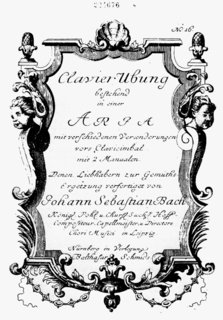A harpsichord concerto is a piece of music for an orchestra with the harpsichord in a solo role. Sometimes these works are played on the modern piano. For a period in the late 18th century, Joseph Haydn and Thomas Arne wrote concertos that could be played interchangeably on harpsichord, fortepiano, and pipe organ.
The Italian Concerto, BWV 971, originally titled Concerto nach Italienischen Gusto, is a three-movement concerto for two-manual harpsichord solo composed by Johann Sebastian Bach and published in 1735 as the first half of Clavier-Übung II. The Italian Concerto has become popular among Bach's keyboard works, and has been widely recorded both on the harpsichord and the piano.

Christophe Rousset is an internationally renowned French harpsichordist and conductor, specializing in the performance of baroque music on period instruments. He is also a musicologist, with a passion for opera and European music of the 17th and 18th centuries, and is the founder of the French music ensemble Les Talens Lyriques.

Johann Sebastian Bach was a German composer and musician of the Baroque period. He is known for instrumental compositions such as the Art of Fugue, the Brandenburg Concertos, and the Goldberg Variations as well as for vocal music such as the St Matthew Passion and the Mass in B minor. Since the 19th-century Bach Revival he has been generally regarded as one of the greatest composers of all time.
Lars Ulrik Mortensen is a Danish harpsichordist and conductor largely in Baroque solo and chamber music and Early music repertory. He was a professor in Munich in 1996-99 and has since then been artistic director of Concerto Copenhagen. He received the Léonie Sonning Music Prize in 2007.
The harpsichord concertos, BWV 1052–1065, are concertos for harpsichord, strings and continuo by Johann Sebastian Bach. There are seven complete concertos for a single harpsichord, three concertos for two harpsichords, two concertos for three harpsichords, and one concerto for four harpsichords. Two other concertos include solo harpsichord parts: the concerto BWV 1044, which has solo parts for harpsichord, violin and flute, and Brandenburg Concerto No. 5 in D major, with the same scoring. In addition, there is a nine-bar concerto fragment for harpsichord which adds an oboe to the strings and continuo.
Concerto Köln is a Baroque music chamber ensemble.

Johann Ernst of Saxe-Weimar was a German prince, son by his second marriage of Johann Ernst III, Duke of Saxe-Weimar. Despite his early death he is remembered as a collector and commissioner of music and as a composer some of whose concertos were arranged for harpsichord or organ by Johann Sebastian Bach, who was court organist in Weimar at the time.

The concerto for two harpsichords in C minor, BWV 1060, is a concerto for two harpsichords and string orchestra by Johann Sebastian Bach. It is likely to have originated in the second half of the 1730s as an arrangement of an earlier concerto, also in C minor, for oboe and violin. That conjectural original version of the concerto, which may have been composed in Bach's Köthen years (1717–1723), is lost, but has been reconstructed in several versions known as BWV 1060R.
The sonata in G major for two flutes and basso continuo, BWV 1039 is a trio sonata by Johann Sebastian Bach. It has four movements:
Non sa che sia dolore, BWV 209, is a secular cantata composed by Johann Sebastian Bach and first performed in Leipzig in 1747.
Jonathan Cohen is an English cellist and conductor. He is Artistic Director and founder of the British early music ensemble Arcangelo, Artistic Director of Tetbury Music Festival, Artistic Partner of the Saint Paul Chamber Orchestra, Music Director Designate of Les Violons du Roy (Canada) where he will take up the full role from the 2018-19 season, and Associate Conductor of Les Arts Florissants.

The sonatas for viola da gamba and harpsichord, BWV 1027–1029, are three sonatas composed by Johann Sebastian Bach for viola da gamba and harpsichord.
The Triple Concerto, BWV 1044, is a concerto in A minor for traverso, violin, harpsichord, and string orchestra by Johann Sebastian Bach. He based the composition on his Prelude and Fugue BWV 894 for harpsichord and on the middle movement of his Organ Sonata BWV 527, or on earlier lost models for these compositions.

The concerto transcriptions of Johann Sebastian Bach date from his second period at the court in Weimar (1708–1717). Bach transcribed for organ and harpsichord a number of Italian and Italianate concertos, mainly by Antonio Vivaldi, but with others by Alessandro Marcello, Benedetto Marcello, Georg Philipp Telemann and the musically talented Prince Johann Ernst of Saxe-Weimar. It is thought that most of the transcriptions were probably made in 1713–1714. Their publication by C.F. Peters in the 1850s and by Breitkopf & Härtel in the 1890s played a decisive role in the Vivaldi revival of the twentieth century.

Johann Sebastian Bach's output include two types of organ concertos:
Pascal Vigneron is a French classical musician, both trumpeter, organist, and conductor.









